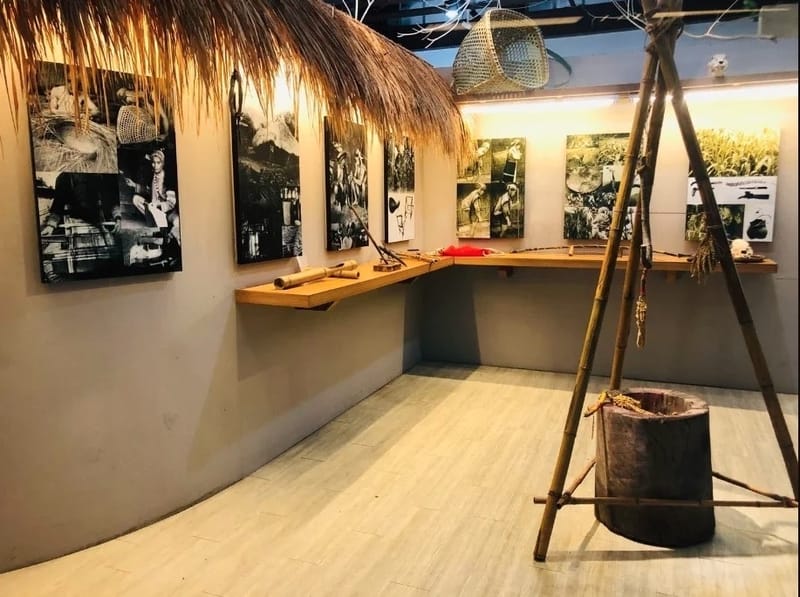Hamo History and Art Museum

Clan Migration
Clan migration routes can be divided among the northern , central , and southern routes.
The northern route goes from Yushan to the northwest along the Chenyoulan river to host, then to Habuhabu near Lukushan , then diverges toward the western face of Alishan. After that it diverges into two routes, one goes around Hohcubu to Tfuya and Tapanqu , like that of the Niahosa Clan. The other follows the Qingshui River directly to the Chiayi Plain, like that of the Yasiungu Clan.
The southern route goes along the eastern bank of the Nanzihsian River from Yushan until it diverges into three paths at Mang’sana : one goes directly west until reaching Yiskiana , like that of the Yaisikana tribe, one goes south to a place near Yayanga , then turns west toward Yiskiana or Ngibiei , like that of the Noacachiana clan, and one goes south to Yangiacana or Niahosa near Siaezonu , then turns northwest , like that of the E’ucna. The three branches of the southern route all diverge west from the Nanzihsian River toward the Zengwen River Basin.
The central route crosses over the Ma’an range (Taataka mountain saddle) from Yushan to Psoseongana (near Alishan) and turns towards Yingiana and Yiskiana , like that of the Yakumangana Clan.
Emoo No Persia , Worship House
Emoo No Peisia is the worship house where ritual take place. According to Kanori Ino’s record , offering were cooked in a tomngo-no-muy(ancient earthenware) inside the Emoo No Peisia during the rituals. Ordinarily , this ancient earthenware was hung in the Emoo No Peisia of the Peongsi (chief). Not only is it rarely used , touching it with one’s hands is also forbidden. The Emoo No Peisia used to be inside a large Emoo (house). It was separated from the Emoo during the Japanese Colonial Era. In early years , the aquatic animals were not considered as clean as terrestrial animals. Therefore fish cannot be close to holly millet. To cook fish in the Emoo No Peisia to he house that contained the Emoo No Peisia inside was strictly forbidden. Once entering the Emoo No Peisia , there are hʉ fʉ (racks for holding animal bones)on the left hand side and ketpʉ (for placing food) on the right hand side. The beds made of rotten and thatching and placed around the fire pit.
A Stringent hierarchical System
The society of the Tsou Tribe is symbolized by the establishment of the Kuba. The internal relations of its political substrate are mainly based on blood relations and gradually extend to integrate geographic relationships. The internal authority structure is set out on the basis of the organizational principles of a patriarchal kinship system. Authority is based on kinship relationships and their interaction. Social status is defined through the course of the aforementioned history of the establishment and development of the tribe and the hierarchy of branches within the clans. Further , clan status and the internal status within the tribe are produced through the interaction of kinship and age stratification. Marriage among clans further stabilizes and maintains the internal authority structure. As such , situations in which traditional status is obtained through strong individual abilities are relatively rare.
In other words, political relations among the Individual and the group are established based on paternal kinship , and extended in accordance with blood relations. The name of the entitled ‘’peongsi’’ (chief) becomes the clan name of the united clan , and the authority inherited mainly signifies the principles of kinship it’s based on.
The Battle Ritual
The battle ritual (the Mayasvi) is a solemn ritual of the Tsou tribe. Originally the time of the battle ritual was not fixed ; however it was usually after the annihilation ritual , performed after the heads of enemies were taken , and the millet harvest ritual. Since the Tsou tribe’s way of life has changed drastically in recent years , battles in which the heads of enemies were taken no longer take place and religious beliefs are no longer based on the agricultural harvest of millet , they have in fact been replaced by western religious beliefs. The time and way in which the Mayasvi is conducted now is completely different from the ritual in the past.
All of the men participating in the ritual smear pig’s blood on the knives sheathed at their waist and carry their knives toward a sacred tree , smearing the blood on the tree. Then , five warriors climb the tree trunk , cutting down branches , symbolizing the construction of a road for the war spirit as well as the renewal of life. At the end , three branches remain : one pointing in the direction of the Kuba , one in the direction of the clan presiding the ceremonies , one in the direction of another ancient clan , to let the spirits descend from above.
The footprint of the God
According to legend, Hamo, the god of the Tsou people, is also in human form, with huge eyes, and is dressed in bearskin or red robes that reach to his heels. The gods descended on Mountain Jade, shook off the maple leaves, created the ancestors of the Tsou people, and gradually multiplied and formed various clans and tribes. Later, the flood was a disaster, the earth became a sea, and people fled to Yushan in a hurry. When the flood receded, the god stepped out footprints in the forest with his feet, and the tribe settled down, and Tefuye was the first footprint.
Tefuye is also considered to be the earliest founder of the existing Tsou settlements. The Guo family and the Gao family were the first to live in the two clans, about a thousand years ago. Later, other surnames joined in one after another, and gradually developed into a large society. Later, due to the increase in population, it was not easy to cultivate land. About 760 years ago, there were 310 More than a hundred people moved to Laiji, and 200 years later, another 15 people from two families moved to Leye.
Background
The ancestors of the Tsou people once lived in Anping, Tainan, and hunted sika deer for the Dutch, and left behind the place name of ca'aham. During the Zheng Dynasty, with the increase of Han people entering Taiwan, the tribe retreated from the coast to the Zhulu tribe at the foot of Ali Mountain, and moved to the mountain during the Qing Dynasty, forming two major societies, Dabang and Tefuye.
Men's Clubhouse (Kuba)
The most important symbol of the big society of the Tsou people is the men's meeting place, which is the center of religious, political and economic activities in the tribe. The main purposes of the clubhouse are men's education, tribal meetings, gathering for battles, ritual training, hunting and socializing, etc. It is a place for inheritance education, consultation and gathering, and also a place for handling public affairs. The clubhouse is not only a symbol of the tribe, but also closely integrated with the annual war sacrifice ceremony, which is an important cultural symbol of the Tsou people.
Houses (emo)
Houses of the Tsou people use bamboo and thatch as building materials. There are two types of shapes: rectangular and oval. The house space symbolizes both genders, and there are two entrances and exits. The door facing east is defined as the entrance for men; the door facing west is defined as the back door, which is the entrance for women. The courtyard in front of the house has an exclusive space for placing firewood and animal bones, and it is also a place for drying grain and offering sacrifices. It belongs to men's space; the backyard is mostly chicken and pig houses, which is a living space for women.


